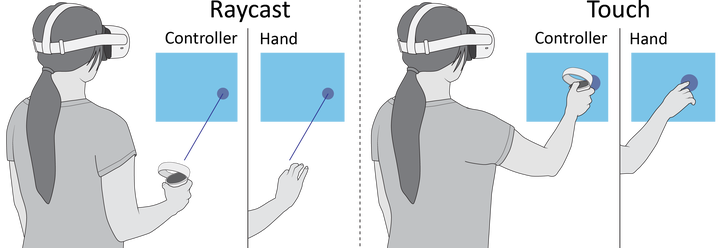Controllers or Bare Hands? A Controlled Evaluation of Input Techniques \on Interaction Performance and Exertion in Virtual Reality

Abstract
Virtual Reality (VR) systems have traditionally required users to operate the user interface with controllers in mid-air. More recent VR systems, however, integrate cameras to track the headset’s position inside the environment as well as the user’s hands when possible. This allows users to directly interact with virtual content in mid-air just by reaching out, thus discarding the need for hand-held physical controllers. However, it is unclear which of these two modalities—controller-based or free-hand interaction—is more suitable for efficient input, accurate interaction, and long-term use under reliable tracking conditions. While interacting with hand-held controllers introduces weight, it also requires less finger movement to invoke actions (e.g., pressing a button) and allows users to hold on to a physical object during virtual interaction. In this paper, we investigate the effect of VR input modality (controller vs. free-hand interaction) on physical exertion, agency, task performance, and motor behavior across two mid-air interaction techniques (touch, raycast) and tasks (selection, trajectory-tracing). Participants reported less physical exertion, felt more in control, and were faster and more accurate when using VR controllers compared to free-hand interaction in the raycast setting. Regarding personal preference, participants chose VR controllers for raycast but free-hand interaction for mid-air touch. Our correlation analysis revealed that participants’ physical exertion increased with selection speed, quantity of arm motion, variation in motion speed, and bad postures, following ergonomics metrics such as consumed endurance and rapid upper limb assessment. We also found a negative correlation between physical exertion and the participant’s sense of agency, and between physical exertion and task accuracy.